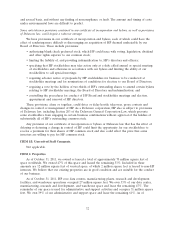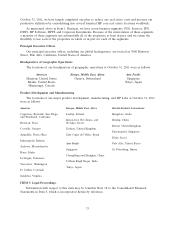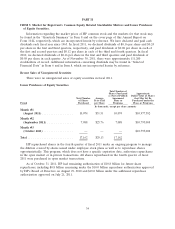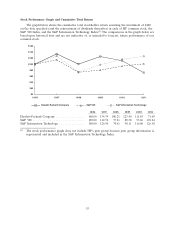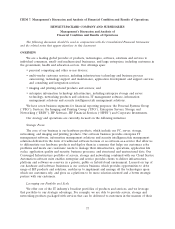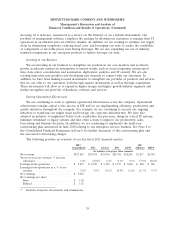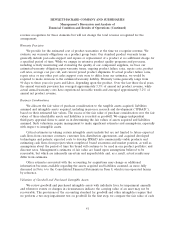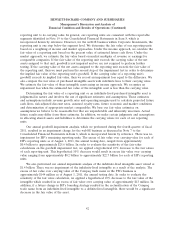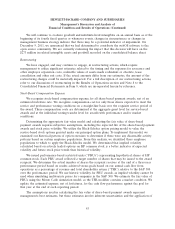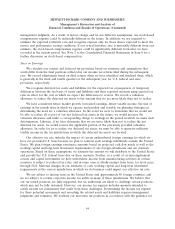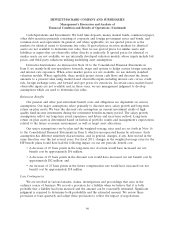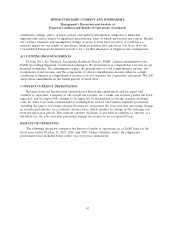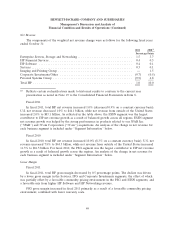HP 2011 Annual Report Download - page 47
Download and view the complete annual report
Please find page 47 of the 2011 HP annual report below. You can navigate through the pages in the report by either clicking on the pages listed below, or by using the keyword search tool below to find specific information within the annual report.HEWLETT-PACKARD COMPANY AND SUBSIDIARIES
Management’s Discussion and Analysis of
Financial Condition and Results of Operations (Continued)
Cash and cash equivalents at October 31, 2011 totaled $8.0 billion, a decrease of $2.9 billion from
the October 31, 2010 balance of $10.9 billion. The decrease for fiscal 2011 was due primarily to
$10.5 billion of net cash paid for business acquisitions, $10.1 billion of cash used to repurchase common
stock and $3.5 billion net investment in property, plant and equipment, the effect of which was partially
offset by $12.6 billion of cash provided from operations and $8.3 billion from the net issuance of debt.
We intend the discussion of our financial condition and results of operations that follows to
provide information that will assist in understanding our Consolidated Financial Statements, the
changes in certain key items in those financial statements from year to year, and the primary factors
that accounted for those changes, as well as how certain accounting principles, policies and estimates
affect our Consolidated Financial Statements.
The discussion of results of operations at the consolidated level is followed by a more detailed
discussion of results of operations by segment.
For a further discussion of trends, uncertainties and other factors that could impact our operating
results, see the section entitled ‘‘Risk Factors’’ in Item 1A, which is incorporated herein by reference.
CRITICAL ACCOUNTING POLICIES AND ESTIMATES
General
The Consolidated Financial Statements of HP are prepared in accordance with U.S. generally
accepted accounting principles (‘‘GAAP’’), which require management to make estimates, judgments
and assumptions that affect the reported amounts of assets, liabilities, net revenue and expenses, and
the disclosure of contingent assets and liabilities. Management bases its estimates on historical
experience and on various other assumptions that it believes to be reasonable under the circumstances,
the results of which form the basis for making judgments about the carrying values of assets and
liabilities that are not readily apparent from other sources. Senior management has discussed the
development, selection and disclosure of these estimates with the Audit Committee of HP’s Board of
Directors. Management believes that the accounting estimates employed and the resulting balances are
reasonable; however, actual results may differ from these estimates under different assumptions or
conditions.
The summary of significant accounting policies is included in Note 1 to the Consolidated Financial
Statements in Item 8, which is incorporated herein by reference. An accounting policy is deemed to be
critical if it requires an accounting estimate to be made based on assumptions about matters that are
highly uncertain at the time the estimate is made, if different estimates reasonably could have been
used, or if changes in the estimate that are reasonably possible could materially impact the financial
statements. Management believes the following critical accounting policies reflect the significant
estimates and assumptions used in the preparation of the Consolidated Financial Statements.
Revenue Recognition
We enter into contracts to sell our products and services, and, while the majority of our sales
agreements contain standard terms and conditions, there are agreements that contain multiple elements
or non-standard terms and conditions. As a result, significant contract interpretation is sometimes
required to determine the appropriate accounting, including whether the deliverables specified in a
multiple element arrangement should be treated as separate units of accounting for revenue recognition
purposes, and, if so, how the price should be allocated among the elements and when to recognize
39





